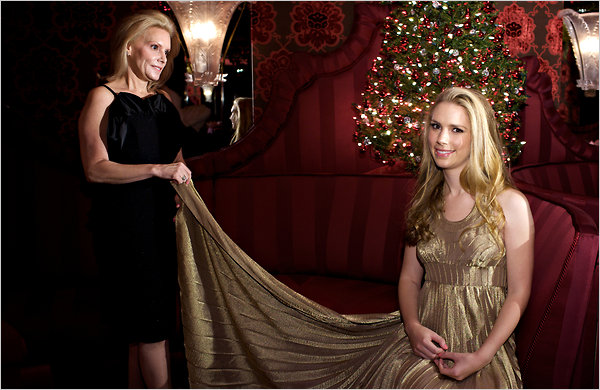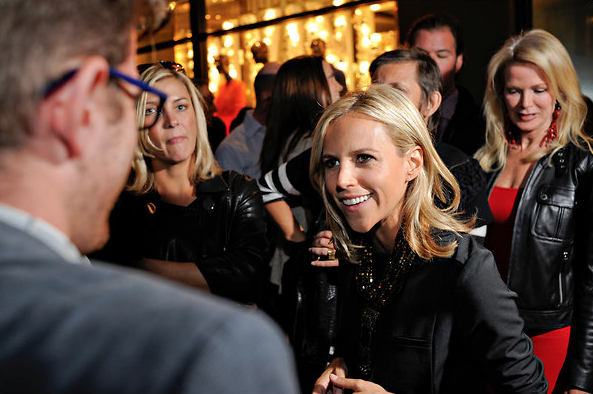The recent assassination attempt in Tucson led to calls for civic unity, and that event was followed by the national commemoration of Martin Luther King, Jr., which included celebrations of diversity. Unity and diversity are good things, and they are especially good when found together. Political rhetoric doesn’t neatly follow society stratification, however, and so this might be a moment to consider how some of the time society seems dedicated to a third option: homogeneity.
Newspapers no longer announce that they have what once were called “society pages,” but they have them nonetheless. This photograph from the New York Times is a priceless example of high status social reproduction. And I don’t use the term “reproduction” lightly, as you are looking at a mother and daughter. Even accounting for the differences to be expected between a young woman and a woman of a certain age, mother and daughter are not particularly similar in appearance. Until, that is, you notice their hair. Neither may be a natural blonde, but what does that matter? Both are definitely blonde, and that includes a lot more than a narrow slice of the visual spectrum. This is a picture of wealth, status, and the pride and poise that comes with those gifts.
The photo also is a study in what can’t be hidden by any lifestyle. (Fashion always reveals more than itself.) Mother and daughter are nicely balanced as figures in the composition, but they also are visibly separated by each other, joined only by the train of the dress as if it were a golden yoke. Growing separation between parents and children is a necessary feature of this phase of their life together, but one wonders how much each is trapped within the many demands of her respective role. The daughter is clearly posed, almost like a prize poodle on a leash, but the mother also is posed, indeed, is the more distant and cold for not looking at the viewer. Both are offered for view, but the mother is almost pure object, a sculpture of a woman; one can’t help but think she now is paying the price for benefiting earlier from the femininity on display. And while both are bathed in yellow light, the mother is wrapped in black that blends into the dark background. The daughter seems encased more than clothed in her golden gown, but at least she appears vibrant, while her mother is already fading to dark as if being slowly drawn into the oblivion of death.
So youth is still growing into its social skin while mortality stalks us all. No news there. What matters is how society deals with its universals, and here the picture turns harsher yet. These women are creatures of light–you can see the photographer’s flash reflected in the back of the room–and that light is a product of social hierarchy. What seems a static composition, carefully posed within a tableau of elegance, is a portrait of enormous social energy being forced into narrow channels. That may be one definition of discipline, but it also is the base reality of how elites reproduce their social order.
And so a photograph of a blonde mother showcasing her blonde daughter is a study in competition and exclusion. The two actual persons may have the best of relationships, but the photograph captures a deep tension of aristocratic life: the heir in waiting. Is the queen really ready to let go and step into the darkness? Is the heir apparent really ready to wait so long, and isn’t she already taking pride in her youthful vigor, her ability to already displace the older woman where it really counts? If peace reigns for a while, isn’t it because they remain united against all those they are keeping out–those who can only hope to imitate the standard they embody?
Others do imitate, of course–why are there so many blondes?–and there is nothing like a fashion show to expose the fangs behind the social smile.
Blonde on blonde on blonde. . . . . multiple imitations of the same, right down to the black jackets, and ready to pile it on or cut each other off as needed to win the male gaze. Young women and an older woman, united by fashion if not by blood, they are creatures of light drawn to the light–in this case, a guy who needs only to show up to activate a contest for recognition. The brunette in the background is the only hint of difference. (She’s not even looking in the right direction and may actually be having a conversation; must be a reporter or something equally ridiculous.) And unity? It had better get in line.
Homogeneity is neither diversity nor unity, but something else entirely: a regime of social reproduction that succeeds by pushing both difference and unity down the social hierarchy. It is both natural and artificial: like the blonde.
Photographs by Deidre Schoo and Casey Kelbaugh for the New York Times.


[…] Blonde on Blonde on Blonde Sobre el color del pelo. […]